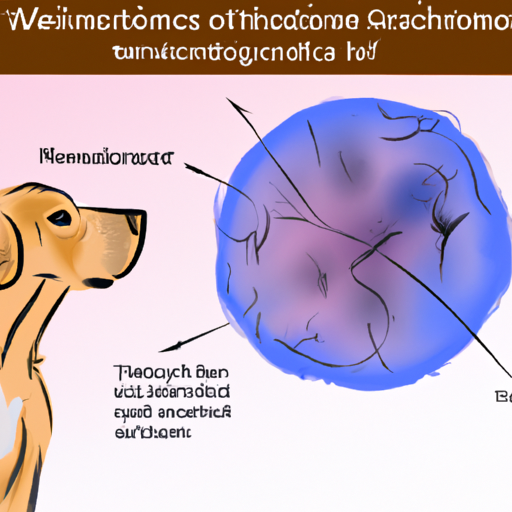Understanding Mast Cell Tumors
Mast cell tumors (MCTs) are a frequent form of skin cancer found in dogs. They’re formed by the abnormal proliferation of mast cells, a type of white blood cell that plays a crucial role in your dog’s immune response. While MCTs can be benign or malignant, they’re usually aggressive and can spread to other parts of the body.
Your dog’s skin is the most common place for MCTs, but they can also appear in the spleen, liver, or bone marrow. Breed, age, and other factors can influence the likelihood of your dog developing MCTs. Boxers, Boston terriers, Labrador retrievers, Beagles and Schnauzers are among the breeds most commonly affected.
Identifying Mast Cell Tumors
- Physical Appearance: MCTs can appear as small bumps or large, ulcerated masses on your dog’s skin. They may be soft or firm to touch, and can change in size rapidly.
- Symptoms: Common symptoms include itching, redness, swelling, and discomfort. In severe cases, dogs can experience vomiting, lack of appetite, and lethargy.
It’s important to remember that MCTs can mimic the appearance of less serious skin conditions. If you notice any suspicious lumps or changes in your dog’s behavior, consult a veterinarian immediately.
Diagnosing Mast Cell Tumors
Diagnosing MCTs typically involves several steps:
- Physical Exam: The vet will conduct a thorough physical examination of your dog, checking for lumps or skin abnormalities.
- Fine Needle Aspiration (FNA): A needle is used to extract cells from the tumor for microscopic evaluation.
- Histopathology: If the FNA confirms the presence of MCTs, a biopsy may be performed to determine the tumor grade and potential treatment options.
| Type of Test | Purpose |
|---|---|
| Physical Exam | Identify physical abnormalities |
| Fine Needle Aspiration | Confirm presence of MCTs |
| Histopathology | Determine tumor grade and treatment options |
Treatment Options for Mast Cell Tumors
Treatment for MCTs depends on the tumor’s size, location, grade, and whether it has spread to other parts of the body. Here are the most common treatment options:
- Surgery: The first line of treatment, it involves removing the tumor and a margin of healthy tissue around it.
- Radiation Therapy: Used when surgery is not an option or when the tumor cannot be completely removed.
- Chemotherapy: Often used in conjunction with surgery or radiation therapy, it can help control the spread of the disease.
- Targeted Therapy: Drugs like toceranib can target specific abnormalities within cancer cells.
Remember, your vet will choose the best treatment plan for your dog based on various factors, including your dog’s overall health and the specific characteristics of the MCT.
Preventing Mast Cell Tumors
Preventing MCTs can be challenging due to their unpredictable nature. However, certain steps can be taken to improve your dog’s overall health and potentially reduce the risk:
- Regular Vet Check-ups: Early detection is key in managing MCTs.
- Healthy Diet: A balanced diet can strengthen your dog’s immune system.
- Sun Protection: Limit your dog’s exposure to intense sunlight as UV rays can harm the skin.
FAQ
1. Can mast cell tumors be cured in dogs?
The cure depends on the grade and stage of the tumor. Early detection and aggressive treatment can significantly improve a dog’s prognosis.
2. Are mast cell tumors painful for dogs?
MCTs can cause discomfort and itching. If the tumor is internal, it may cause vomiting or loss of appetite.
3. Can mast cell tumors go away on their own?
MCTs generally do not regress without treatment. If you notice any suspicious lumps on your dog’s skin, consult a vet immediately.
4. How long can a dog live with a mast cell tumor?
The prognosis varies widely and depends on the tumor’s grade and stage, as well as the dog’s overall health. Some dogs can live for years with MCTs, while others may have a more limited lifespan.
5. Are certain breeds more susceptible to MCTs?
Yes, certain breeds like Boxers, Boston terriers, Labrador retrievers, Beagles and Schnauzers are more prone to developing MCTs. However, any breed can be affected.
Remember, being a caregiver to a dog means being vigilant about their health. If you notice any changes in your dog’s skin or behavior, don’t hesitate to contact a vet. The sooner an MCT is detected, the better the chances for successful treatment.



